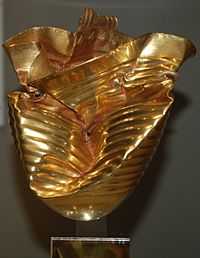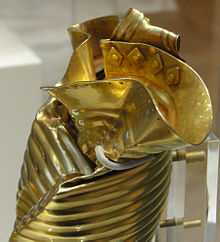Ringlemere Cup
 Photographed on 29 August 2007 | |
| Material | Gold |
|---|---|
| Created | 1700-1500 BC |
| Discovered | Ringlemere barrow in 2001 |
| Present location | British Museum |
The Ringlemere Gold Cup is a Bronze Age vessel found in the Ringlemere barrow near Sandwich in the English county of Kent in 2001 by metal detectorist Cliff Bradshaw.[1] Although badly crushed by recent plough damage it can be seen to have been 14 cm high with corrugated sides. The cup resembles a late Neolithic (approximately 2300 BC) ceramic beaker with Corded Ware decoration, but dates to a much later period.
Only seven similar gold "unstable handled cups" (unstable because round-bottomed) have been found in Europe, all dating to the period between 1700 and 1500 BC. The Ringlemere cup is most similar to the other British example, the Rillaton gold cup found in Cornwall in 1837. The other examples are two from Germany, two from Switzerland, one now lost from Brittany, and an unprovenanced, perhaps German, example. Two silver and, from Britain two amber and some shale cups share the same basic shapes (see Hove amber cup). The finds in Britain are in the approximate Wessex area, and on the continent near the Rhine or the Channel coast, suggesting that the vessels, though probably all made fairly locally to their find spots, related to a specific cross-channel trading zone.[2]
History

It is thought that the cup was not a grave good however but a votive offering independent of any inhumation, which was placed at the centre of the barrow in approximately 1700 - 1500 BC. No contemporary burials have in fact been found at the site, although later Iron Age ones have since been found, along with a Saxon cemetery.
Mr. Cliff Bradshaw is an amateur archaeologist and metal detectorist, whose main area of interest is the early Anglo-Saxons of 400AD - 600AD. His fascination for this period led him to undertaking studies and the scouring of the local countryside of south-east Kent for Anglo-Saxon remains. In the course of his explorations as a detectorist he found a number of items including a beautiful silver Anglo-Saxon strap end, three sceattas, and many brooch fragments fairly close together. The number and proximity of these items led him to believe that they were not simply accidental losses but that this was an inhabited Saxon settlement and that he would find a burial mound nearby. Over the twelve to fifteen months he had access to the field he carefully scanned all aspects of the land and in doing so was able to make out the faint outline of a raised section of field. Without wanting to jump to conclusions he felt sure that this was what he was looking for. He commenced his detecting to the south side of the mound and very quickly found an Anglo-Saxon gilded brooch at a depth of eight to ten inches. The following day he continued his search on the northern perimeter of his suspected Saxon burial site; he knew from his experience as a detectorist that he would have a better chance of making a discovery on the shallower edge of the mound than he would at the deeper centre. He found the Ringlemere Cup. This was to prove to have important consequences for him as he was now obliged to stop his search for confirmation of Saxon burials.
Mr. Bradshaw was certain the cup was not Saxon; he also knew that the Saxons placed a great importance on prehistoric earthworks and used them for their burials. That evening he discovered the similarities his find had with the Rillaton Cup. He was convinced that the gold cup belonged to an earlier age, revered and left alone by the Anglo-Saxons who had used the site for their burials.
Mr. Bradshaw reported the find of the cup to the local coroner's office, and through the Portable Antiquities Scheme and the Treasure Act 1996 the cup was recorded and declared to be treasure in 2002. It was bought by the British Museum for the amount of £270,000 (roughly US$520,000), with the money paid split between Mr. Bradshaw and the Smith family who own Ringlemere Farm. The money to secure the cup for the nation was raised through donations by the Heritage Lottery Fund, the National Art Collections Fund and The British Museum Friends. This also enabled the site to be properly excavated, revealing a funerary complex of Early Bronze Age date (approximately 2300 BC) on the site.
On the first site visit Mr. Bradshaw said that this was an Anglo-Saxon burial, but Mr. Keith Parfitt, the local archaeologist replied, ‘This is a Bronze Age Barrow of great importance, we won’t find any Saxons here’. Mr. Bradshaw pointed out that the gilded brooch was very likely from a grave and that his studies indicated that the Anglo-Saxons used these ancient barrows for their dead. Again Mr. Parfitt replied ‘Not in Kent’. However a report written later by Mr. Parfitt appears to give credence to Mr. Bradshaw’s thoughts; he wrote that the brooch found by Mr. Bradshaw could be derived from a plough damaged grave and that ‘Anglo-Saxon cemeteries, focused on Prehistoric Barrow sites, are becoming increasingly well known’.
From the moment he discovered the mound in November 2001 and against all opposing statements from the archaeologists on site, Mr. Bradshaw continued to insist that this was an Anglo-Saxon Burial Site. Finally in the summer of 2004 he was vindicated when Anglo-Saxon burials were found on the south side of the barrow. This discovery overturned the earlier hypothesis that a single sunken hut indicted that the Saxons had chosen the spot for habitation.
Much controversy has reigned over the location of the find of the Gold Cup. Mr. Bradshaw had paced measured from a nearby electricity pole. However, it appears that this did not suit the theories of the local archaeologists and no first hand account from Mr. Bradshaw was sought for the publication The Ringlemere Cup edited by S Needham, K Parfitt & G Varnell, British Museum Oct 10 2006. On reviewing the book John Barrett, professor of archaeology at the University of Sheffield found it strange that it lacked a first hand account by the finder.
The cup was number 10 in the list of British archaeological finds selected by experts at the British Museum for the 2003 BBC Television documentary Our Top Ten Treasures which included an interview with Bradshaw.
From 14 May 2004 until 13 January 2006 the cup appeared in the Museum's "Buried Treasure" exhibition on treasure trove, both at the Museum itself and touring (to the National Museum & Gallery of Wales at Cardiff, Manchester Museum, the Hancock Museum at Newcastle, and the Norwich Castle Museum & Art Gallery). On its return to London, it was on temporary display in Room 2 of the British Museum, with the Rillaton cup, until 17 October 2006. From 17 October to 26 February 2007 it was on temporary display in Dover Museum, closer to its find-spot, and it is now back in the Prehistory galleries at the British Museum.
See also
Notes
- ↑ Barkham, Patrick (13 February 2007). "Metal gurus: For years, metal detector fans have been accused of pillaging Britain's past. Now the culture minister says they are 'unsung heroes'. But who'd want to spend all day in a muddy field with a machine that won't stop beeping?". The Observer.
- ↑ BMRP, Section 8, "conclusion" and 9, "catalogue"
References
- "BMRP": The Ringlemere Cup: Precious Cups and the Beginning of the Channel Bronze Age - available online, Editors: Stuart Needham, Keith Parfitt and Gillian Varndell; Contributors: Aaron Birchenough, Chris Butler, Caroline Cartwright, Stuart Needham, Susan La Niece, Keith Parfitt, Gillian Varndell, British Museum Research Publication 163, ISBN 978-086159-163-3
- Hobbs, Richard (2003), Treasure : finding our past, British Museum, ISBN 978-0-7141-2321-9
External links
- This article is about an item held in the British Museum. The object reference is The Ringlemere gold cup.
| |||||||||||||||||||||||||||||||||||||||||||||||||||